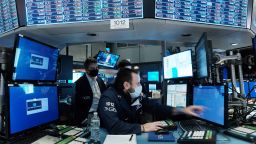Editor’s Note: Dana Peterson is an executive vice president and chief economist at The Conference Board. The opinions expressed in this commentary are her own.

Prices are rising for nearly everything, biting into everyone’s income. But the surging cost of food, specifically, hits especially hard, exacerbating the wealth and income disparities between the richest and poorest Americans.
The Federal Reserve has been patient throughout the Covid-19 pandemic about achieving full employment to help the broadest set of Americans. Now, it is pivoting toward fighting inflation. This shift is critical to help tame higher prices in virtually every category and will require a measured and well-communicated plan to raise interest rates.
One of the more closely watched categories is food, as soaring prices have hit consumers’ pocketbooks, especially those least able to afford it. Food prices in December 2021 increased by 6.3% from a year earlier, according to the Bureau of Labor Statistics’ (BLS) Consumer Price Index. This is the fastest pace of food-price inflation since October 2008, when swelling energy prices lifted the cost of other commodities.
Now, pandemic dynamics are driving inflation: sick workers, supply chain disruptions, transportation bottlenecks and labor shortages, not to mention bad weather events, have forced the price of food higher. Food consumed at home is up 6.5% year-over-year, with prices for staples like meats, poultry, fish and eggs spiking by 12.5% year-over-year. Fruit and vegetable prices climbed to a 10-year high (5%) in December. Food in restaurants, too, is up 6% year-over-year. And prices for full- and limited-service meals and snacks (i.e., dine-in restaurants and takeout) have risen at the fastest pace on record, according to BLS data.
These levitating prices exacerbate food insecurity. According to the Census Bureau’s Household Pulse Survey, 42 million Americans said in early January that they lacked sufficient food because they couldn’t afford to buy enough. That number is nearly double what it was in April as prices rose and stimulus payments (e.g., checks, enhanced federal unemployment insurance) dwindled or ended.
Food-insecure families tend to have incomes below the poverty line of $26,500 for a family of four, but those with incomes just above it or in the lower middle class are also feeling food pressure. Additionally, ethnic minority groups (Black 17%, Hispanic 15%) are more likely than their White (6%) peers to cite food insecurity, according to The Conference Board’s calculations of the Census Bureau’s Household Pulse Survey.
In a modern economy, no one should struggle to eat because of spiking food prices.
Still, we could see prices rising even further. US CEOs see rising inflation as their second greatest externally facing concern for the year ahead, after labor shortages, according to The Conference Board C-Suite Outlook 2022 survey. An outsized 74% said they are facing upward pricing pressures for inputs (e.g., raw materials, other supplies, wages), with 66% blaming supply chain bottlenecks for higher costs, and 50% citing labor shortages as causes.
When asked how they would manage these rising costs, 56% of CEOs said that passing price increases on to customers would be their first choice. Only about one-third stated that they might absorb prices into profit margins (36%) or cut costs (32%) as a first option. While these sentiments pertained to all goods and services, this is likely to be particularly acute for food producers and providers. As long as the lingering pandemic gums up supply chains and constricts the labor supply, firms may feel obligated to raise prices, especially for food.
Fed action is the key to any quick relief. Interest rate hikes will slow certain aspects of the economy, like housing activity, more intensely than others. But rate rises should also help calm inflationary pressures, especially as the temporary drivers of higher food prices, including supply chain disruptions, persist.
Raising interest rates from zero percent, and gradually reducing the size of the balance sheet, would also ensure that runaway prices, or even a wage-price spiral, do not damage consumers and hamstring businesses. Since the Great Recession, financial markets have been wary of the Fed’s attempts to tighten policy. Recall, for example, the taper tantrum of 2013 and the 2018 selloffs when the Fed attempted to “normalize” interest rates.
Now, though, financial markets should recognize that the Fed’s efforts to fight inflation are in their interest as they will stabilize the economy. Fed policymakers are signaling several interest rate hikes this year, and markets may become nervous after the first few. However, by using effective communication now, the Fed should seek to convince investors that its actions are not to be feared, but welcomed to keep the US economy on track and help many Americans whose spending is vital to continued growth.
























